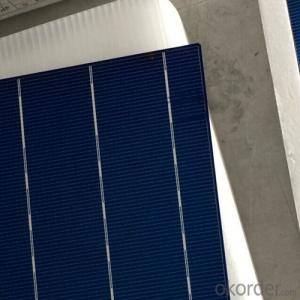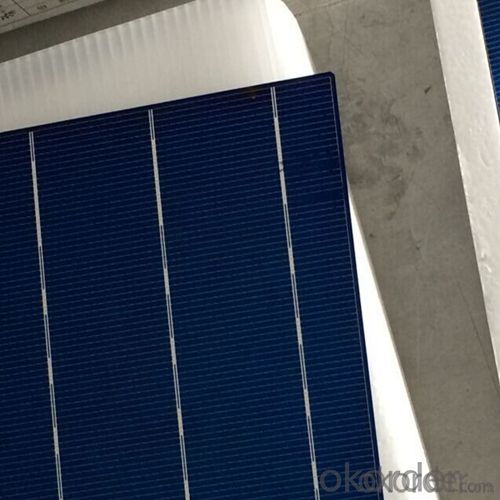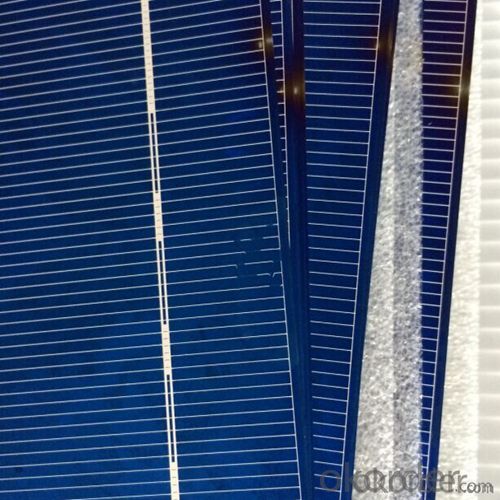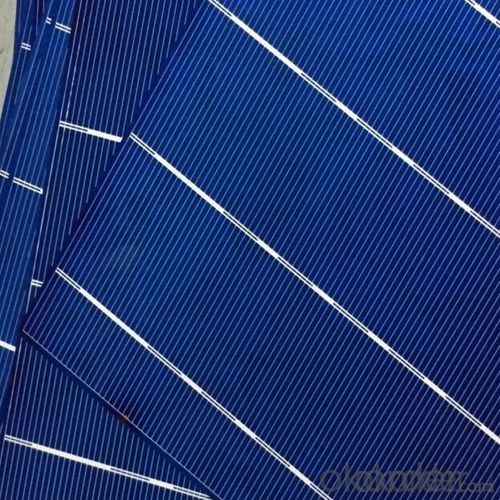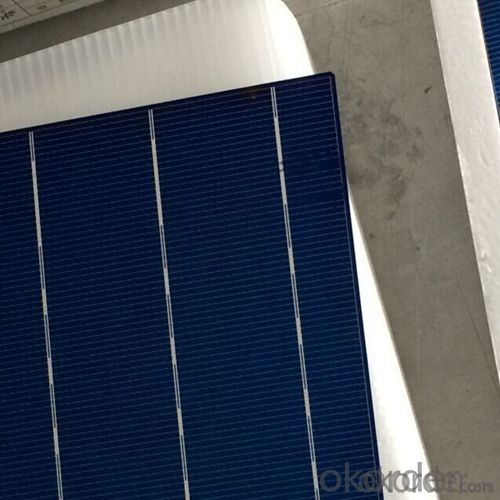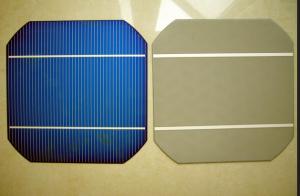Jinko Solar Cells - Not Broken with Low Price and High Efficiency
- Loading Port:
- Shanghai
- Payment Terms:
- TT or LC
- Min Order Qty:
- 30000 pc
- Supply Capability:
- 1000000 pc/month
OKorder Service Pledge
OKorder Financial Service
You Might Also Like
Product description
Solar Cells Not Broken with Low Price and Gigh EFF
A solar cell, or photovoltaic cell, is an electrical device that converts the energy of light directly into electricity by the photovoltaic effect, which is a physical and chemical phenomenon.[1] It is a form of photoelectric cell, defined as a device whose electrical characteristics, such as current, voltage, or resistance, vary when exposed to light. Solar cells are the building blocks of photovoltaic modules, otherwise known as solar panels.
Solar cells are described as being photovoltaic irrespective of whether the source is sunlight or an artificial light. They are used as a photodetector (for example infrared detectors), detecting light or other electromagnetic radiation near the visible range, or measuring light intensity.
In contrast, a solar thermal collector supplies heat by absorbing sunlight, for the purpose of either direct heating or indirect electrical power generation from heat. A "photoelectrolytic cell" (photoelectrochemical cell), on the other hand, refers either to a type of photovoltaic cell (like that developed by Edmond Becquerel and modern dye-sensitized solar cells), or to a device that splits water directly into hydrogen and oxygen using only solar illumination.
Advantage Of Solar Cells Not Broken with Low Price and Gigh EFF
1: High quality cell, Level A cell (14%—17.5%)
2.Dimensione:156*156mm Diagonal:200mm
3: Qualified certification: TUV,CE certification.
4: Warranty: five years for whole unit
Usage/Application Of Solar Cells Not Broken with Low Price and Gigh EFF
1.The absorption of light, generating either electron-hole pairs or excitons.
2.The separation of charge carriers of opposite types.
3.The separate extraction of those carriers to an external circuit.
Product Images

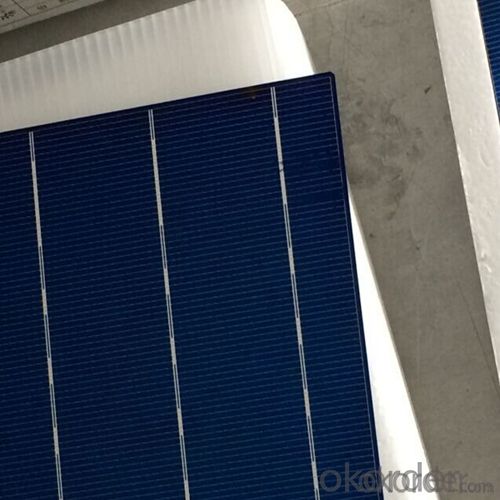

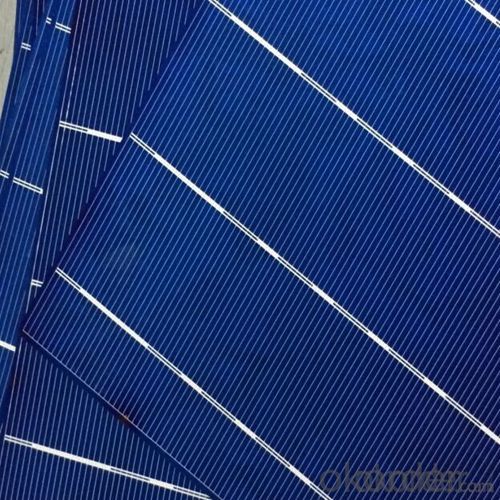
Electrical Characteristic
Efficiency (%) | Pmpp (W) | Umpp (V) | Impp (A) | Uoc (V) | Isc (A) | FF (%) |
17.25 | 4.197 | 0.524 | 7.992 | 0.62 | 8.458 | 80.03% |
17 | 4.137 | 0.524 | 7.876 | 0.619 | 8.353 | 80.01% |
16.75 | 4.076 | 0.522 | 7.81 | 0.617 | 8.286 | 79.73% |
16.5 | 4.015 | 0.518 | 7.746 | 0.613 | 8.215 | 79.73 |
16.25 | 3.955 | 0.515 | 7.683 | 0.61 | 8.144 | 79.61% |
16 | 3.894 | 0.512 | 7.613 | 0.608 | 8.075 | 79.31% |
15.75 | 3.833 | 0.51 | 7.534 | 0.605 | 8.058 | 78.62% |
15.5 | 3.772 | 0.508 | 7.453 | 0.604 | 8.02 | 77.87% |
15.25 | 3.771 | 0.505 | 7.35 | 0.604 | 9.997 | 76.83% |
15 | 3.65 | 0.503 | 7.271 | 0.604 | 7.989 | 75.64% |
14.5 | 3.529 | 0.499 | 7.067 | 0.604 | 7.988 | 73.14% |
14 | 3.407 | 0.499 | 6.833 | 0.604 | 7.833 | 72.01% |
Intensity Dependence
Intensity [W/m2] | Isc× [mA] | Voc× [mV] |
1000 | 1.00 | 1.000 |
900 | 0.90 | 0.989 |
500 | 0.50 | 0.963 |
300 | 0.30 | 0.939 |
200 | 0.20 | 0.920 |
Packaging & Delivery Of Poly Solar Cell 156mm | |
Packaging Detai | Packaging Detail:Export Carton and Pallet or under customer request. |
Delivery Detail:10-20days | |
FAQ
Q:What price for each watt?
A:It depends on the quantity, delivery date and payment terms
Q:What is your warranty system?
A:Our Solar cells performance guarantees for 25 years
Q:How do you pack your products?
A:We have rich experience on how to pack thecells to make sure the safety on shipment when it arrives at the destination.
- Q: What is the role of solar cells in powering remote monitoring systems?
- Solar cells play a crucial role in powering remote monitoring systems as they provide a sustainable and renewable source of energy. By converting sunlight into electricity, solar cells eliminate the need for traditional power sources or frequent battery replacements in remote locations. This ensures continuous operation of monitoring systems, allowing data collection, transmission, and analysis to occur even in areas with limited access to the electrical grid. Solar cells enable reliable and environmentally friendly power supply, making them an essential component for remote monitoring systems.
- Q: What materials are commonly used in solar cells?
- Some common materials used in solar cells include silicon, cadmium telluride, and copper indium gallium selenide.
- Q: Briefly explain why solar cells are made into components
- The main photovoltaic material is the crystalline silicon material (including polysilicon and monocrystalline silicon), this material is high hardness, brittleness, uneven force easily brittle, exposed to the air easily oxidized, and the use of the process can not
- Q: Can solar cells be used to charge batteries?
- Yes, solar cells can definitely be used to charge batteries. Solar cells convert sunlight into electricity, which can be used to charge batteries for various applications such as powering small devices or storing energy for later use.
- Q: What is the maximum efficiency possible for a solar cell?
- The maximum efficiency possible for a solar cell, also known as the Shockley-Queisser limit, is approximately 33.7%.
- Q: Where and how can we find the best solar cells suppliers?
- The good solar cell supplier won't just show up at your door, you need to dive into the solar cell market and get to know them by visiting the factories.
- Q: How do solar cells perform in areas with high levels of pollen allergies?
- Solar cells can generally perform well in areas with high levels of pollen allergies. While the presence of pollen might lead to some dust accumulation on the surface of the solar panels, it does not significantly impact their performance. Regular cleaning and maintenance can help ensure optimal efficiency of the solar cells, even in areas with high pollen levels.
- Q: What is the impact of solar cells on reducing electricity bills?
- Solar cells have a significant impact on reducing electricity bills as they harness the power of the sun to generate clean and renewable energy. By producing electricity on-site, solar cells can offset a considerable portion of a household's or business's energy consumption, leading to substantial savings on monthly electricity bills. Moreover, excess energy generated by solar cells can be fed back into the grid, allowing homeowners and businesses to earn credits or even receive payments for the surplus energy they contribute. Overall, solar cells offer a sustainable and cost-effective solution to reduce electricity bills and promote energy independence.
- Q: What is the lifespan of a solar cell battery?
- The lifespan of a solar cell battery can vary depending on various factors such as usage, quality, and maintenance. On average, a well-maintained solar cell battery can last anywhere from 5 to 25 years. However, advancements in technology and improvements in battery design are continually increasing the lifespan of solar cell batteries.
- Q: Can somebody list some of the materials used for making solar cells?
- Silicon is one of the most important and expensive materials to make solar cells.
Send your message to us
Jinko Solar Cells - Not Broken with Low Price and High Efficiency
- Loading Port:
- Shanghai
- Payment Terms:
- TT or LC
- Min Order Qty:
- 30000 pc
- Supply Capability:
- 1000000 pc/month
OKorder Service Pledge
OKorder Financial Service
Similar products
Hot products
Hot Searches
Related keywords
